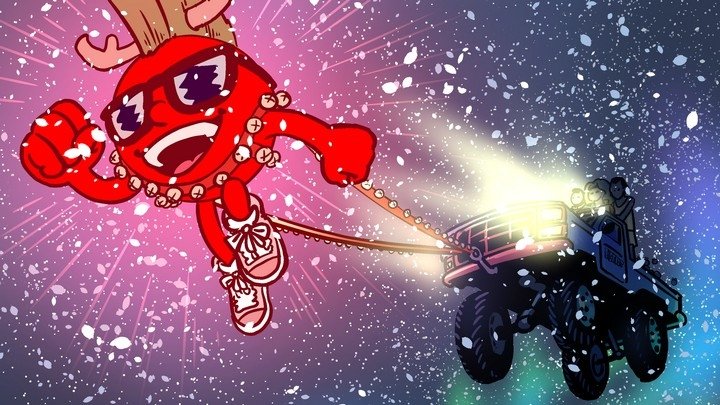Super NES Mini Countdown: #7 | Contra III: The Alien Wars
"If it scales, we can kill it."
Nintendo's Super NES Classic Edition mini-console arrives at the end of the month, and the Retronauts writing team has voted to rank the 20 classic games on the mini. Unlike last year's Classic NES Edition, the Super NES mini doesn't have a single dud on it, so think of this as a countdown from good to great. Lucky number seven is a game you'll need all the luck you can get (or at least some Restore Points) to see the end of.
Previous entries:
- 20. Super Punch-Out!!
- 19. F-Zero
- 18. Kirby's Dream Course
- 17. Donkey Kong Country
- 16. Star Fox
- 15. Super Mario RPG
- 14. Secret of Mana
- 13. Super Mario Kart
- 12. Street Fighter II Turbo: Hyper Fighting
- 11. Super Ghouls 'n' Ghosts
- 10. Kirby Super Star
- 9. EarthBound
- 8. Final Fantasy III

7. Contra III: The Alien Wars
Dev.: Konami
Publisher: Konami
Genre: Run-and-gun
Release date: Feb. 1992 [JP] Apr. 1992 [U.S.] Nov. 1992 [EU]
What makes Contra III a worthy inclusion?
Playing with super power
As a relatively early addition to the Super NES's library, Contra III served as a straightforward example of the advances promised by the burgeoning 16-bit era. With run-and-gun action largely unchanged from Contra and Super C back on the NES, it takes after its predecessors even more than Super Mario World, the new system's earliest title, resembles Super Mario Bros. 3. As such, the changes that are present make themselves heard loud and clear—such as the addition of hanging and climbing to the player's move set, the ability to switch between two weapon slots for twice the firepower, and the inclusion of the screen-clearing bombs from the arcade version of Super Contra. The graphics immediately demonstrate a cut above even the most refined 8-bit fare, and the soundtrack is a rich evolution of Konami's classic sound. It's all so familiar, yet obviously so much more.
Made to order
Unlike the two NES Contra games, which began as a pair of arcade games which were adapted for the home market, Contra III was built from the ground up for a console—and not just any console. Halfway through Stage 1, an airplane comes screaming out of the background, rotating and scaling in size as it does so, and bombs the pavement under your feet, submerging the city in exquisitely transparent flames. Later in the game, a mid-boss trains a conical searchlight on you that realistically skews as it follows you around the screen. Bomb items and boss explosions appear as circular hazes that radiate smoothly from their source to tint the entire screen. It never feels quite as much like a tech demo as Super Castlevania IV, but it comes close in the two overheard stages, where the player must use the L and R shoulder buttons to rotate the stage as they roam about seeking out prescribed targets. Konami certainly designed Contra III with the Super NES's unique capabilities in mind.

Up to eleven
The Contra series is known for throwing the player into all manner of over-the-top situations, and that custom began right here. While previous games were held back by technical limitations, Contra III exercises the power of the Super NES to depict bring its action movie roots into focus. Right at the beginning of Stage 1 sits a sharp orange future car, there for no reason but to let you make something explode spectacularly within seconds of starting. As you charge through the city streets, dogs eating from overturned garbage cans wait until you walk past to dramatically turn their faces to the camera and give chase. The aforementioned mid-stage bombing leaves you to make the rest of your way dangling from railings over a raging inferno, and upon reaching a dead end, an ominous swell of the soundtrack cues the first boss, who comes crashing at you through a wall.
The third-to-last stage is arguably the game's climax, beginning as an auto-scrolling jet bike ride with a blinding sense of speed. After fending off myriad implements of death on the underbelly of a giant airship, you take to the skies yourself, jumping between a never-ending salvo of missiles crashing into the dreadnought, which you of course have to shoot down while trying not to crater the pavement yourself. Even today, other games dream of set pieces as exhilarating as Contra III's.

Everyone goes home
As compelling as Contra III is, it takes on a different shape entirely when two players go at it together. And while it's hardly the only multiplayer game on the Super NES Classic—nor the only cooperative one—the simple, immediate gameplay and high difficulty combine to form a bonding experience far more visceral than you might find in Secret of Mana or Kirby Super Star. Just remember to discuss your weapon preferences beforehand to avoid the awkwardness of swiping that nice Crush gun from under your buddy's nose in a moment of apocalyptic chaos.
The sweet spot
Contra III was the last installment in the series before it largely departed from the concept of level design and settled into a "bosses on parade" format, which can at times feel like eating cake that's made of nothing but frosting. Fifteen years later, Contra 4 made a concerted effort to return to the series' roots, but it was really looking more to the balance of the NES games than the number right before it. Contra III marks the point where the series transitions from one structure to the other, and so it features aspects of both worlds, with plenty of mid-level boss encounters but also decent stretches of down-home running and gunning in between.

Interesting facts about Contra III
One, two, four
Contra III was originally previewed in magazines under the title Super Contra IV. Konami took it down a peg somewhere prior to release, either to avoid confusion with Super Castlevania IV or because no one could figure out which extant Contra game constituted "the third one" after Contra and Super C. The mention of "Neo City" in the final game's manual echoes the apocryphal Contra Force, so maybe that was the thought...but I prefer to believe the honor would have gone to the rather overlooked Operation C on Game Boy.
Rebels from canon
As with the NES games, Contra III underwent a graphical overhaul in Europe, redrawing all humanoid figures to be overtly robotic—presumably playing to the strict media watchdogs in countries like Germany. As the reskinned series was known as Probotector, so too was the title changed to Super Probotector: Alien Rebels, apparently recasting the player characters as alien soldiers (robotic ones, of course) who starting having second thoughts about this whole "invasion" thing.
But the story didn't go unscathed in the States, either. In the manual of the original Contra, Konami's American copywriters had changed the setting from the twenty-seventh century to the good ol' 1980s, which became a hard sell when Contra III came along with its unmistakably futuristic environs. Their solution? Change the names of Bill and Lance, our returning heroes, to "Jimbo and Sully," the original pair's supposed descendants.

One super deserves another
The Contra arcade games never made the same splash as their NES adaptations, and they still tend to be downplayed in the series' history. Surprisingly, though, Contra III lifts a fair amount of inspiration from 1988's Super Contra, as though it's actually more a follow-up to that game than Super C on NES. As mentioned, the bomb item returns, and the two games have very similar openings, with a giant red text scroll and a brief conversation between lovingly lip-flapped close-ups of Bill and Lance (though Contra III lacks actual digitized voice samples). The Mother Alien, the penultimate boss from Super Contra, returns amidst the final stage's boss rush as the souped-up Metal Alien. And while Contra III's last boss, Gabba, also appeared in Super C, Super Contra was the first game where it served as the player's final opponent.
You've got moxie
Two years after Contra III's debut, Konami published a downscaled conversion to the Game Boy. What's interesting about this version is that it was developed by Factor 5, the German developer who made their name with the Turrican series, which lifted more than a little inspiration from Contra. It was a similar situation to Twentieth Century Fox contracting Konami themselves to make an official Aliens game after they'd thoroughly plagiarized that movie's aesthetics with—you guessed it—Contra. The sentiment in both cases was evidently "We think you can make our game...because you already have."
How hard is your spirit?
Porting Super NES games to Game Boy Advance was a popular custom in the early aughts, as was Frankensteining content from unused sources and related games into quasi-new selling points. In 2002, Konami provided one of the most egregious examples of this with Contra Advance: The Alien Wars EX. In lieu of simply converting Contra III to portable form with greater fidelity than the original Game Boy could manage, this version strips out the rotating overhead stages and replaces them with, of all things, stages from Contra: Hard Corps—a Sega Genesis game, mind you, and one with graphics that don't match up to Contra III in the slightest. It works as well as you'd expect, which is to say it's thoroughly off-putting. The best thing about it is easily its Japanese title, which draws from Contra Spirits (as Contra III is known in Japan) and Hard Corps to give us "Contra Hard Spirits."
A peaceful time will come
In the Japanese version of the game, the ending changes depending on the player's chosen difficulty setting, subtly expanding as the challenge rises. For the Western versions, Konami infamously ran with this idea with cruel results: The ending now only plays at all if you complete the game on the utterly overwhelming Hard mode, and anything less earns you nothing more than a screen of text admonishing you to try harder. Easy and Normal also exclude the true last boss, which was originally only true of the former. If that weren't enough, they limited the number of continues you can use and removed all the cheats that might have helped a struggling player tackle Hard mode, including the classic Contra thirty-life code. Even the Western versions of Super C sufficed to demote it to a ten-life code, but Contra III knows no such mercy.
Hauntingly familiar
Contra III shares a composer with Castlevania IV — Masanori Adachi — and as a result, the two games also share certain unique musical elements, notably some very specific timpani and string samples. The two soundtracks sound nothing alike, of course; Castlevania IV was all about subdued, layered jazz influences, whereas Contra III brings wave after wave of orchestral bombast. Listen carefully to the two games as you play them and you might just gain a little more appreciation for the way a talented musician can create completely different moods from the same palette of sounds.




